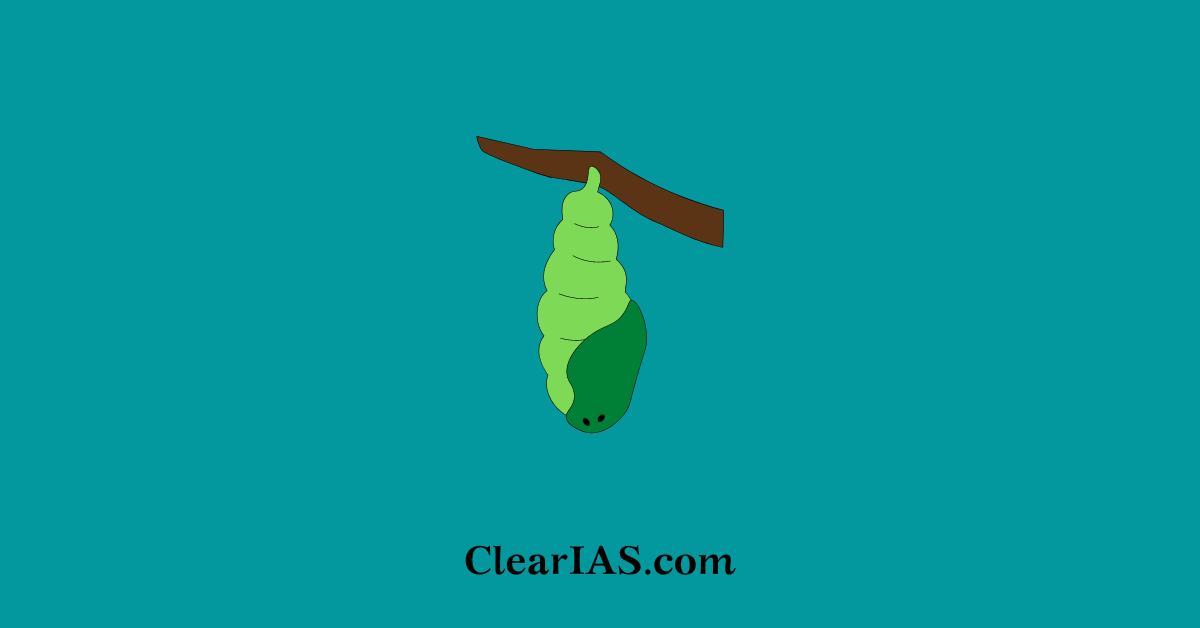
Many nations’ domestic economies place a great deal of importance on sericulture. The top two manufacturers of silk worldwide are China and India.
Over 60% of the world’s total silk production is produced in these two nations together.
The development of sericulture in the nation will be supported by the Government of India’s Central Sector Scheme “Silk Samagra,” which has received funding of 2161.68 crores for three years, from 2017 to 2020.
What is Sericulture?
Sericulture is the practice of raising silkworms and harvesting their silk. The most widely employed species of silkworm in sericulture are the larvae of the domestic silk moth, also known as “Bombyx Mori.”
For the creation of “wild silks,” other varieties of silkworms (such as Eri, Muga, and Tasar) are also raised in captivity.
- Sericulture, a cottage business, contributes significantly to the creation of jobs and the reduction of poverty.
- It is one of the most lucrative rural activities.
- Low-cost access to indigenous technology.
- Quick and consistent returns.
- Hand-woven silks are very in demand and well-liked in the West.
- Silk clothing is frequently worn at festive events and is in high demand domestically.
- To meet domestic demand, there is a significant output deficit.
- Room to grow for organized sector and large production units.
- It will be more efficient to use the byproducts effectively.
History
Silk production in India has a rich history, dating back to ancient times. Sericulture is believed to originate in China.
- B. Mori discovered the making of silk in 2700 BC. Although there is much earlier evidence of silk cultivation in archaeological archives.
- Cultivation began in India in 140 AD.
- Later, it spread to Europe, the Mediterranean region, and other Asian nations.
- In several nations, including China, Japan, India, Korea, Brazil, Russia, Italy, and France, sericulture has emerged as one of the most significant cottage industries.
- Presently, more than 60% of the world’s supply is produced annually by the two largest producers, China and India.
It has been an integral part of Indian culture and economy for centuries. The states of Karnataka, Andhra Pradesh, Tamil Nadu, West Bengal, and Assam are the leading silk-producing states in the country, with Karnataka accounting for more than 70% of the country’s total mulberry silk production.
What is the Process Followed in Sericulture?
The sericulture procedure for making mulberry silk consists of three main steps.
- Moriculture – the cultivation of mulberry leaves.
- Silkworm rearing – promoting the growth of the silkworm.
- Silk reeling – the extraction of silk filaments from the silkworm cocoons.
The silk fibers are finally weaved together to create a thread. To create yarn, these threads are frequently spun together.
Also, read about Major crops and cropping patterns.
Moriculture
The cultivation of mulberry plants, whose leaves are utilized as silkworm food, is referred to as moriculture. Three alternative techniques can be used to grow these plants:
- Cultivation from seeds
- Root-grafting
- Stem grafting
The most popular technique for mulberry plantations is stem grafting. Here, stems from mature mulberry plants are cut into cuttings that are about 22 centimeters long and have at least three buds on them. These cuttings can either be planted right away or they can be stored in nurseries before being transplanted.
The mulberry leaves can be harvested from the plants via the following methods:
- Leaf picking – the removal of individual leaves by hand.
- Branch cutting – removal of the entire branch.
- Top shoot harvesting – removal of the mulberry shoot tops.
Notably, 50 silkworms can be fed with 1 kilogram of mulberry leaves (from the egg stage to the cocoon stage).
Silk Production in India
Five main categories of commercially significant silk are produced by several species of silkworms. These include Muga, Eri, Mulberry, Oak Tasar, and Tropical Tasar.
- Mulberry Silk: The most common type of silk, produced by the domesticated silkworm, Bombyx mori, which feeds on mulberry leaves. It is primarily produced in Karnataka, Andhra Pradesh, Tamil Nadu, and West Bengal.
- Eri Silk: Produced by the Samia cynthia ricini worm, which feeds on castor leaves. Eri silk is primarily produced in the northeastern states of India. It is known for its thermal properties and is often used in products like shawls and quilts.
- Tasar Silk: A type of wild silk obtained from the silkworm, Antheraea mylitta, which feeds on the leaves of the Asan and Arjun trees. Tasar silk is mainly produced in the forested areas of Jharkhand, Chhattisgarh, Odisha, and Maharashtra.
- Muga Silk: Exclusive to the state of Assam, muga silk is produced by the silkworm Antheraea assamensis, which feeds on the leaves of the Som and Soalu plants. Muga silk is known for its natural golden color and durability.
Other non-mulberry kinds of silks include wild silks, also referred to as vanya silks.
All these commercial types of silk are produced only in India.
The largest silk-producing region in India is in the south, which is also home to renowned silk-weaving communities like Kancheepuram, Dharmavaram, Arni, etc.
Steps by the Government to develop Sericulture in India
Integrated Scheme for the Development of Silk Sector, which focuses on intervention in crucial areas including feed, seed, breed, post-cocoon technology, and capacity building, is designed to grow the sericulture industry in many states, including Tamil Nadu.
The following are the elements of the plan:
- Research and development, education, technology transfer, and IT initiatives. Organization Seed.
- Coordination and the growth of the market.
- System for Quality Certification, Brand Promotion, and Technology Upgrades
- To produce high-quality Bivoltine silkworm seed, cold storage facilities, and grainages have been upgraded.
- To raise the level of quality and productivity in the manufacturing of silkworm seeds, the Silkworm Seed Act is now being put into effect.
- To lessen drudgery and increase the quality and production of Vanya silk, the Central Silk Board has created cutting-edge technological packages, enhanced farm machinery, indigenous automatic reeling units, and Vanya silk reeling and spinning units.
- By reclassifying non-mulberry sericulture as a forest-based activity under the modified Forest Conservation Act, farmers can now raise Vanya silkworms in their native host plantations within forests.
- The Central Sericulture Training Institute of the Central Silk Board (CSB), which is part of the Indian government, has been offering technical assistance to the weaving and cocoon industries.
- introducing handloom artisans to all four types of silk.
- yarn and spun silk are introduced in Ikkats weaving.
- The Ministry of Textiles has put out several extension programs to enhance the country’s silk infrastructure, some of which involve turning traditional Patola fabrics into clothing.
What are the Challenges Faced in Sericulture?
Several difficulties faced by sericulture silk farmers could potentially ruin their crops. They are also vulnerable to numerous health risks. Pebrine and flacherie are two illnesses that can affect silkworms.
Additional pests pose a threat to the silkworm larvae’s ability to grow healthily. The following is a list of some significant difficulties experienced in sericulture.
- The eggs may become infected with the pebrine illness and perish before the larvae emerge. This sickness causes all larvae to develop dark patches and become listless.
- The larvae’s bodies may contract as a result of viral infections. Additionally, they might begin to emit a disagreeable odor.
- The larvae may become inactive due to other viral diseases including cytoplasmic polyhedrosis.
- The muscardine infection, brought on by fungi, can make the larvae very weak and ultimately kill them.
- Dermestid beetle larvae can dig into silkworm cocoons and consume the pupae. These injured cocoons are unable to reel out silk.
- A toxic chemical that some mites make kills silkworms.
Way forward
The promotion of silk as a luxury fabric and its integral role in Indian traditions, such as weddings and festivals, continues to sustain high demand for Indian silk. With the right blend of traditional skills and modern technologies, India’s silk industry can navigate the challenges ahead and continue to thrive in the global marketplace.
- Promote awareness and education about the importance and benefits of sericulture.
- Encourage government support for sericulture through subsidies, insurance schemes, and tax incentives.
- Establish sericulture parks and centers for research and development.
- Improve infrastructure for mulberry cultivation, silkworm rearing, and silk processing.
- Develop and promote new and improved silk varieties with higher quality and productivity.
- Increase market access for sericulturists through better marketing and distribution channels.
- Foster partnerships between sericulturists and textile industries to ensure a steady demand for silk.
- Encourage the use of eco-friendly techniques and technologies in sericulture.
Article Written by: Remya






Leave a Reply